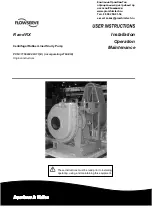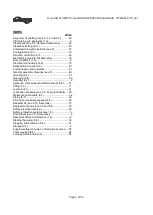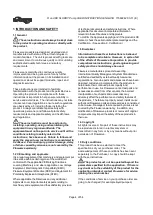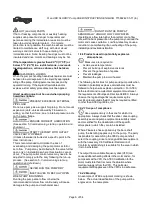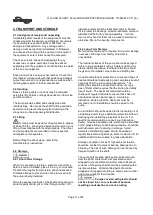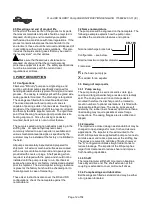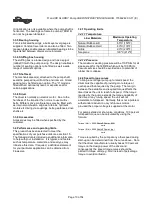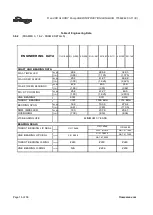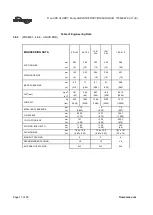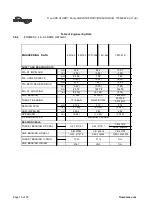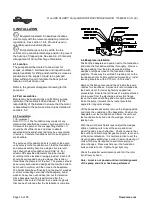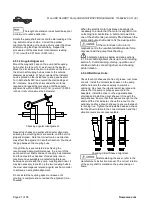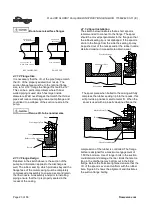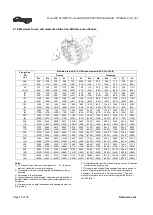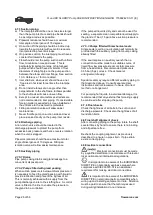
R and RX SLURRY Pump USER INSTRUCTIONS ENGLISH
71569242 03-11 (E)
Page 11 of 54
®
2 TRANSPORT AND STORAGE
2.1 Consignment receipt and unpacking
Immediately after receipt of the equipment it must be
checked against the delivery and shipping documents
for its completeness and that there has been no
damage in transportation. Any shortage and or
damage must be reported immediately to Flowserve
and received in writing within one month of receipt of
the equipment. Later claims cannot be accepted.
Check any crates, boxes and wrappings for any
accessories or spare parts which may be packed
separately with the equipment or attached to side walls
of the box or equipment.
Each product has a unique serial number. Check that
this number corresponds with that advised and always
quote this number in correspondence as well as when
ordering spare parts or further accessories.
2.2 Handling
Boxes, crates, pallets or cartons may be unloaded
using fork lift vehicles or slings dependent on their size
and construction.
The pump should be lifted with suitably sized and
located slings. Do not use the shaft for lifting and take
special care to prevent the pump from rotating in the
slings due to unbalanced weight distribution.
2.3 Lifting
A crane must be used for all pump sets in excess
of 25 kg (55 lb). Fully trained personnel must carry out
lifting, in accordance with local regulations. The driver
and pump weights are recorded on their respective
nameplates or massplates.
Before lifting the driver alone, refer to the
manufacturer’s instructions.
2.4 Storage
2.4.1 Short-Term Storage
When it is necessary to store a pump for a short time
before it can be installed, place it in a dry, cool location.
Protect it thoroughly from moisture and condensation.
Protective flange covers should not be removed until
the pump is being installed.
Wrap the exposed portions of the shaft and coupling to
protect against sand, grit or other foreign matter. Oil
lubricated units should be lubricated (refer to Section
III) to protect the bearings. Grease lubricated units are
lubricated at the factory during assembly. Turn the
rotor over by hand at least once a week to maintain a
protective film on the bearing components.
2.4.2 Long Term Storage
More than precautions are required if long-term storage
in excess of 90 days from factory shipment is
unavoidable.
The internal surfaces of the pump should be sprayed
with a rust preventative such as a water soluble oil or
other suitable alternative. Particular attention should
be given to the impeller, wear plate and stuffing box.
An optional method of protection is to suspend bags of
desiccant material inside casing and completely seal all
openings from the surrounding atmosphere. The
stuffing box should be packed with clean. dry rags.
Use of this method requires that the casing be initially
free of liquid. The desiccant material should be
checked at regular intervals to ensure that it has not
absorbed excessive water vapour. A warning
instruction, advising that the desiccant must be
removed prior to installation should be wired to the
pump.
A rust inhibitor should be added to the lubricating oil of
oil lubricated units to give additional protection without
destroying the lubricating properties of the oil. For
specific recommendations, consult your lubrication
dealer. Grease lubricated units, which can be identified
by the grease fitting at each bearing location, should be
well lubricated prior to placing in storage. Small
amounts of additional grease should be added at
regular intervals during storage. Refer to Section III for
additional information related to grease lubrication.
Storage of pumps in areas of high ambient vibration
should be avoided to prevent bearing damage due to
brinelling. The risk of such damage can be reduced by
frequent rotation of the shaft.
The pump half coupling and key should be removed
from the shaft, coated with rust preventative and
wrapped to prevent metal-to-metal contact. Exposed
surfaces of the pump shaft should be protected with a
rust preventative. All dismantled parts should be
wrapped and tagged according to pump serial number
and a record kept of their location.
Pumps covered with plastic should
not be stored in a cool environment because
resulting condensation can cause rusting
.

